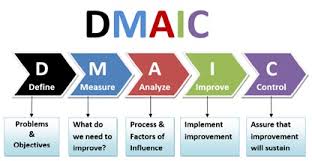Six Sigma Process
Six Sigma Process - Plain & Simple
Six Sigma Process in one way is very simple which comprises five phases called DMAIC - Define, Measure, Analyze, Improve & Control.
We have to keep in mind the ultimate objective of Six Sigma Process i.e. business or process improvements. Why we go through these 5 phases is to improve something which is not right, or has some problems or have some deviations from the target or desired settings.
Six Sigma Methodology is a just a disciplined approach to problem solving and continuous process improvement. Don’t get intimidated with loads of really hard statistics? Well, there is some statistics involved but it’s not that bad! You have the option to use even the simplest of the tools necessary to get the required objective.
Don’t get bogged down that you have to be become a master of statistics – you simply don’t have to, in order to implement Six Sigma.
Here is the Six Sigma Process Improvement Method explained.

Stage 1– Define
As it goes, first things first, Six Sigma first addresses - What’s the problem, why is it really important to solve it? Can you live without solving it? what impact does it make on your usual business … All of these questions need answered up front. The more work done defining the problem, the more likely the problem will be successfully resolved. Six Sigma provides many tools to help define the exact problems or pain areas first. This is the most important part of the project. We use the help of Six Sigma Project Charter to define the pain areas, especially which have an impact on something and we are not willing to live without…
Stage 2 – Measure
If you don’t know the process or how it’s currently performing, how will you know you’ve fixed it? The measure phase of Six Sigma is about understanding and quantifying the current reality, by using tools such as process mapping, collecting and validating data. If it moves, measure it!
Stage 3 – Analyze
At the 3rd stage of Six Sigma methodology, now we get serious about flushing out the root causes of the problem. All sorts of possible statistical tests are done to determine which is the rotten apple spoiling the barrel. This is the point at which a highly trained Six Sigma “Black Belt” gets busy, as they perform the complicated number crunching to identify non value adding steps in the process but also making sure analysis paralysis does not creep in.
Stage 4 – Improve
You’ve found the rotten apples, now it’s time to throw them out. The improve phase of Six Sigma Process is about eliminating the root causes of the problem and/or implementing a solution that will flag early if the process is on a slippery slope to defect land.
Stage 5 – Control
The final control phase of Six Sigma methodology is about getting the process back to business as usual. The project team hands over responsibility to the people in charge of the everyday process, with the added benefit of having prevented the problem from occurring again, or giving them the tools to monitor the process and nip problems in the bud before they grow.
The project charter is reviewed, to ensure all project charter problems & objectives have been met, such as cost reductions and quality improvements. And then it’s time to party, and let the business know about the successful project.
This is the briefest overview of the Six Sigma Process. For more details, check the top panel links…